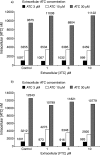In vitro interactions between apricitabine and other deoxycytidine analogues
- PMID: 17517847
- PMCID: PMC1932514
- DOI: 10.1128/AAC.01204-06
In vitro interactions between apricitabine and other deoxycytidine analogues
Abstract
Apricitabine is a novel deoxycytidine analogue reverse transcriptase inhibitor that is under development for the treatment of human immunodeficiency virus type 1 (HIV-1) infection. Apricitabine is phosphorylated to its active triphosphate by deoxycytidine kinase, which is also responsible for the intracellular phosphorylation of lamivudine (3TC) and emtricitabine (FTC); hence, in vitro studies were performed to investigate possible interactions between apricitabine and these agents. Human peripheral blood mononuclear cells (PBMC) were incubated for 24 h with various concentrations of (3)H-labeled or unlabeled apricitabine, 3TC, or FTC. Intracellular concentrations of parent compounds and their phosphorylated derivatives were measured by high-performance liquid chromatography. In other experiments, viral reverse transcriptase activity was measured in PBMC infected with HIV-1 bearing M184V in the presence of various concentrations of apricitabine and 3TC. [(3)H]apricitabine and [(3)H]3TC were metabolized intracellularly to form mono-, di-, and triphosphates. 3TC and FTC (1 to 10 microM) produced concentration-dependent decreases in apricitabine phosphorylation; in contrast, apricitabine at concentrations of up to 30 muM had no effect on the phosphorylation of 3TC or FTC. The combination of apricitabine and 3TC reduced the antiviral activity of apricitabine against HIV-1: apricitabine concentrations producing 50% inhibition of viral reverse transcriptase were increased two- to fivefold in the presence of 3TC. These findings suggest that nucleoside reverse transcriptase inhibitors with similar modes of action may show biochemical interactions that affect their antiviral efficacy. It is therefore essential that potential interactions between combinations of new and existing agents be thoroughly investigated before such combinations are introduced into clinical practice.
Figures




Similar articles
-
Effect of Lamivudine on the plasma and intracellular pharmacokinetics of apricitabine, a novel nucleoside reverse transcriptase inhibitor, in healthy volunteers.Antimicrob Agents Chemother. 2007 Aug;51(8):2943-7. doi: 10.1128/AAC.01013-06. Epub 2007 Jan 22. Antimicrob Agents Chemother. 2007. PMID: 17242147 Free PMC article. Clinical Trial.
-
Resistance profile of the new nucleoside reverse transcriptase inhibitor apricitabine.J Antimicrob Chemother. 2010 Feb;65(2):213-7. doi: 10.1093/jac/dkp422. Epub 2009 Dec 9. J Antimicrob Chemother. 2010. PMID: 20007333 Review.
-
In vitro evaluation of the anti-HIV activity and metabolic interactions of tenofovir and emtricitabine.Antivir Ther. 2006;11(3):377-84. Antivir Ther. 2006. PMID: 16759055
-
Virologic and enzymatic studies revealing the mechanism of K65R- and Q151M-associated HIV-1 drug resistance towards emtricitabine and lamivudine.Nucleosides Nucleotides Nucleic Acids. 2006;25(1):89-107. doi: 10.1080/15257770500379157. Nucleosides Nucleotides Nucleic Acids. 2006. PMID: 16440988
-
Apricitabine: a nucleoside reverse transcriptase inhibitor for HIV infection.Ann Pharmacother. 2009 Oct;43(10):1676-83. doi: 10.1345/aph.1M160. Epub 2009 Sep 8. Ann Pharmacother. 2009. PMID: 19737995 Review.
Cited by
-
HIV-1 Reverse Transcriptase Still Remains a New Drug Target: Structure, Function, Classical Inhibitors, and New Inhibitors with Innovative Mechanisms of Actions.Mol Biol Int. 2012;2012:586401. doi: 10.1155/2012/586401. Epub 2012 Jun 20. Mol Biol Int. 2012. PMID: 22778958 Free PMC article.
-
Pharmacological considerations for tenofovir and emtricitabine to prevent HIV infection.J Antimicrob Chemother. 2011 Feb;66(2):240-50. doi: 10.1093/jac/dkq447. Epub 2010 Nov 30. J Antimicrob Chemother. 2011. PMID: 21118913 Free PMC article. Review.
-
Global gene expression and Ingenuity biological functions analysis on PCBs 153 and 138 induced human PBMC in vitro reveals differential mode(s) of action in developing toxicities.Environ Int. 2011 Jul;37(5):838-57. doi: 10.1016/j.envint.2011.02.010. Epub 2011 Apr 5. Environ Int. 2011. PMID: 21470681 Free PMC article.
-
Analysis of the Endogenous Deoxynucleoside Triphosphate Pool in HIV-Positive and -Negative Individuals Receiving Tenofovir-Emtricitabine.Antimicrob Agents Chemother. 2016 Aug 22;60(9):5387-92. doi: 10.1128/AAC.01019-16. Print 2016 Sep. Antimicrob Agents Chemother. 2016. PMID: 27353267 Free PMC article. Clinical Trial.
-
Effect of Lamivudine on the plasma and intracellular pharmacokinetics of apricitabine, a novel nucleoside reverse transcriptase inhibitor, in healthy volunteers.Antimicrob Agents Chemother. 2007 Aug;51(8):2943-7. doi: 10.1128/AAC.01013-06. Epub 2007 Jan 22. Antimicrob Agents Chemother. 2007. PMID: 17242147 Free PMC article. Clinical Trial.
References
-
- Bethell, R. C., Y. S. Lie, and N. T. Parkin. 2005. In vitro activity of SPD754, a new deoxycytidine nucleoside reverse transcriptase inhibitor (NRTI), against 215 HIV-1 isolates resistant to other NRTIs. Antivir. Chem. Chemother. 16:295-302. - PubMed
-
- Blaise, P., P. Clevenbergh, D. Vaira, M. Moutschen, and P. Dellamonica. 2002. HIV resistance to antiretroviral drugs: mechanisms, genotypic and phenotypic resistance testing in clinical practice. Acta Clin. Belg. 57:191-201. - PubMed
-
- Cahn, P., I. Cassetti, R. Wood, P. Phanuphak, L. Shiveley, R. C. Bethell, and J. Sawyer. 2006. Efficacy and tolerability of 10-day monotherapy with apricitabine in antiretroviral-naive, HIV-infected patients. AIDS 20:1261-1268. - PubMed
-
- Cohen, C., C. Katlama, R. Murphy, J. Gathe, C. Brinson, G. Richmond, P. M. Girard, J. Fessel, A. Liappis, E. Puglia, B. Rodwick, J. Nadler, W. O'Brien, K. Arasteh, M. Otto, S. Viitanen-Erickson, and R. Levy. 2005. Antiretroviral activity and tolerability of Reverset (D-d4FC), a new fluoro-cytidine nucleoside analog, when used in combination therapy in treatment-experienced patients: results of phase IIb study RVT-203. Abstr. Third IAS, abstr. WeOaLB0103.
-
- Delehanty, J., C. Wakeford, L. Hulett, J. Quinn, B. Mccreedy, M. Almond, D. Miralles, and F. Rousseau. 1999. A phase I/II randomized, controlled study of FTC versus 3TC in HIV-infected patients. Abstr. Sixth CROI, abstr. 16.
MeSH terms
Substances
LinkOut - more resources
Full Text Sources
Medical

